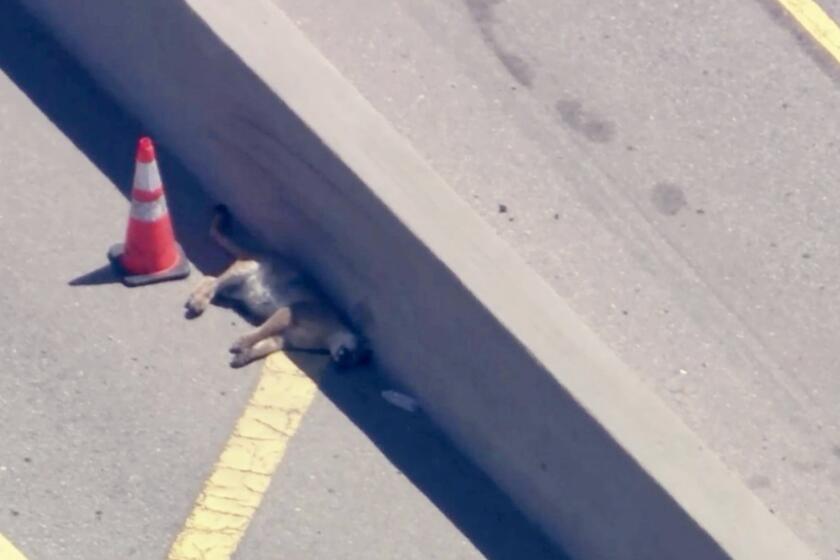A Place to Live, Let Live
Leo Grillo stands on a green hill in Soledad Canyon and gestures toward his mission in life, a 94-acre property he calls an animal sanctuary.
“Birds, coyotes, ravens -- everybody loves it here ‘cause they’re allowed to be free,” he says. “I don’t let them kill mice here, I don’t let them kill rattlesnakes. We put them in 30-gallon buckets.”
Over 25 years, Grillo has made the land the embodiment of his no-kill philosophy: The Acton shelter feeds, houses and cares for rescued animals -- many dumped in national forests around Los Angeles -- no matter how ill or diminished, until they die a natural death.
Grillo’s mission has inspired hundreds of supporters who contributed more than $29.6 million from 2000 to 2004, according to tax returns for his nonprofit organization, Dedication and Everlasting Love to Animals. It also has sparked a running battle with Los Angeles County animal control officials.
And more recently, with prosecutors.
For keeping two partially paralyzed dogs alive, Grillo has been charged with cruelty to animals and operating a kennel without a license. Deputy Dist. Atty. Kelly Cromer, a 19-year prosecutor who specializes in child abuse, said that during a 2004 county inspection, the dogs had sores and fungal infections and couldn’t walk.
Grillo says the dogs were in good condition, despite their paralysis. They died naturally several months after the inspection, he said.
Grillo’s crusade comes against “a changing landscape” of concern about animal cruelty, said Susan Geranen, executive officer of the California Veterinary Medical Board.
About 8 million pets are discarded each year in the United States, including perhaps 4 million that are euthanized, according to experts. Although some animal rights advocates argue that the euthanasia rate can and should be brought to zero, other groups and municipal shelters reluctantly endorse the practice. There simply is no other choice, they say.
“No-kill is a dream for many of us in the sheltering community. This country is not ready to take that pledge,” said Daphna Nachminovitch, director of the domestic animal department of People for the Ethical Treatment of Animals.
Marcia Mayeda, head of Los Angeles County’s animal control program said: “We’ve had people we’ve run into ... responsible for horrible situations of abuse and neglect. These things happen when well-meaning people get overwhelmed and can’t properly care for the animals.”
Grillo believes in no-kill, but, without apologies, he acknowledges he’s a “wacko.”
“You need an extremist to define the situation,” he said.
A former aspiring actor, he said his epiphany came during a road trip, when he saw a stray black dog in apparent distress. He took the animal home.
“We used to go on walks in the forest,” Grillo recalled. “We found more and more dogs starving in the woods. What do you do? You feed ‘em, you go back and feed ‘em.”
He gets about half his funds from contributions and half from bequests -- the largest, $800,000, from a screenwriter he declined to identify.
“It all worked out, because there’s a guiding principle,” said Grillo, who takes no salary, according to the tax documents. “At every fork in the road, the principle is, ‘Do what’s best for the animals.’ ”
That imperative has led him in unusual directions. Grillo does not let people seeking lost pets inspect or adopt his animals, saying he cannot be certain of their treatment if he lets them go.
He insists that because his operation, which he says employs 60 people, is not a kennel, it requires no permit from Los Angeles County.
But prosecutor Cromer said the county has offered to drop all charges if Grillo complies with licensing and rabies requirements and allows access for people looking for lost animals.
Defense attorney Ronald O. Kaye argues that the district attorney’s office is selectively prosecuting Grillo because of the licensing tangle, as well as his fight against Los Angeles County’s method of disposing of dead animals.
Grillo has filed multiple lawsuits against the county over its relationship with D&D; Rendering in Vernon, which received 80,000 animal carcasses from the county in 2003. The company processes and sells some of the remains as animal feed.
Grillo’s lawsuits have not succeeded, but he did manage to pressure the company, the county and the state Department of Food and Agriculture to conduct an inspection of the rendering firm last year.
The agencies concluded that it complied with all state and federal laws and regulations.
Nevertheless, William R. Hess, Grillo’s lawyer for 20 years, said his client “hit a humongous chord with the rendering thing” -- and others agree.
“Let me tell you, there are a lot of pet owners who really, really care what happens after death,” said Rick Wattles, a veterinarian for 36 years who specializes in inspecting clinics.
Wattles said that he has inspected 500 clinics in California and that Grillo’s stands out for the high quality of its medical care.
Kaye’s motion to dismiss the case for selective prosecution is set to be heard today by Los Angeles Superior Court Commissioner John Murphy.
If the motion fails, Grillo will fight the cruelty charge.
At the end of a dirt road and past a guarded gatehouse, Grillo’s shelter houses dozens of neat, fenced cages. Most are centered around low structures dug into the ground and constructed of light materials that let the animals stay cool in the summer.
Workers buzz around in golf carts. One walks an ancient, arthritic dog. There is a hospital, staffed by a full-time veterinarian, which Grillo said was made possible by a $100,000 gift from a benefactor.
A house has been transformed into a dormitory for cats, sheltering hundreds. Grillo points out one, lolling nearby as food is distributed, as among his original tenants.
Grillo waves toward a tree where a raven has just lighted.
“What would you do if there was a little 3-year-old girl under that tree? She’s crying, she’s hungry, she’s hysterical. What would you do? It’s just you and her.
“My ability that’s different from other people is that when I look, I see a 3-year old child.”
More to Read
Start your day right
Sign up for Essential California for news, features and recommendations from the L.A. Times and beyond in your inbox six days a week.
You may occasionally receive promotional content from the Los Angeles Times.






